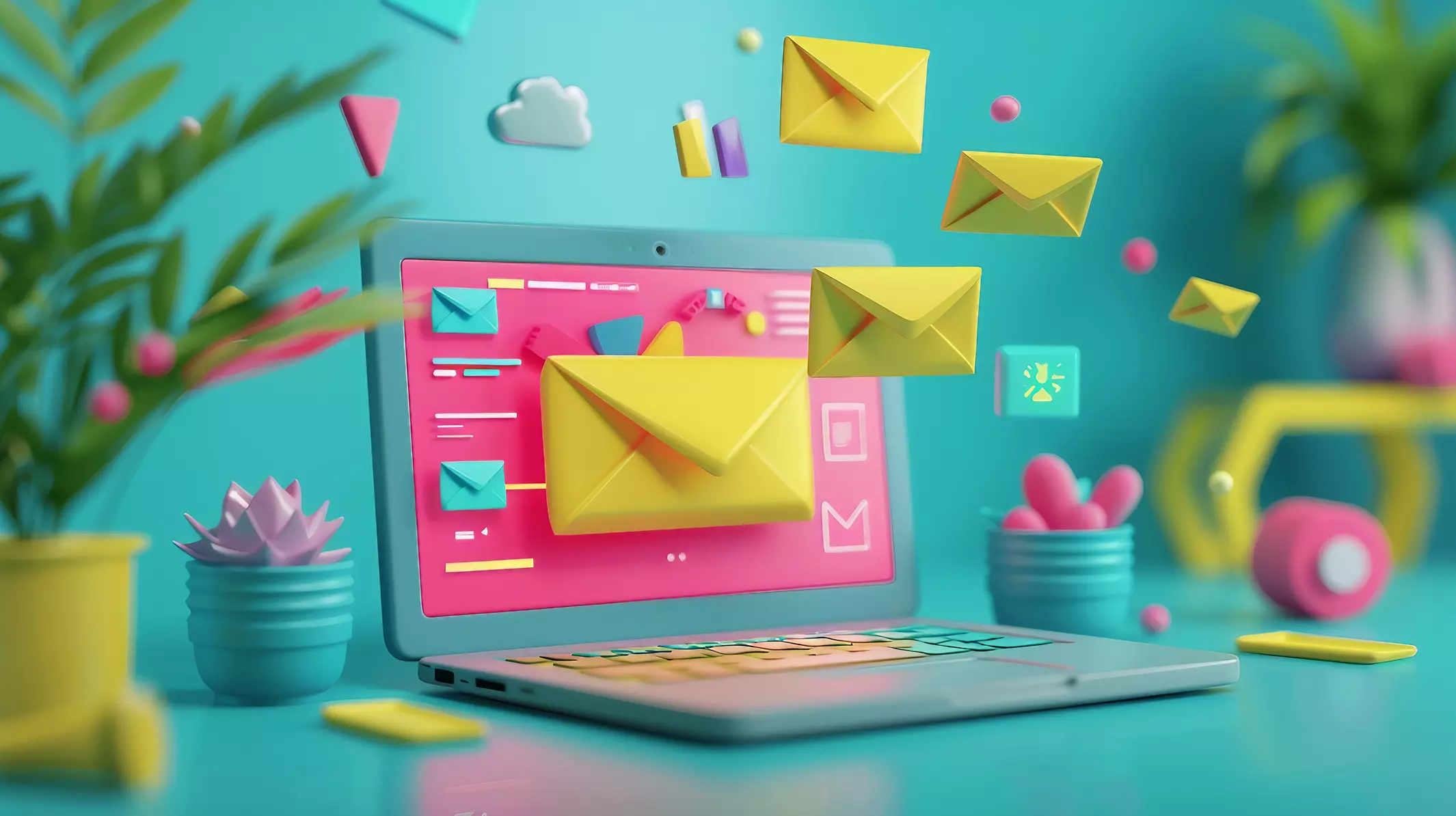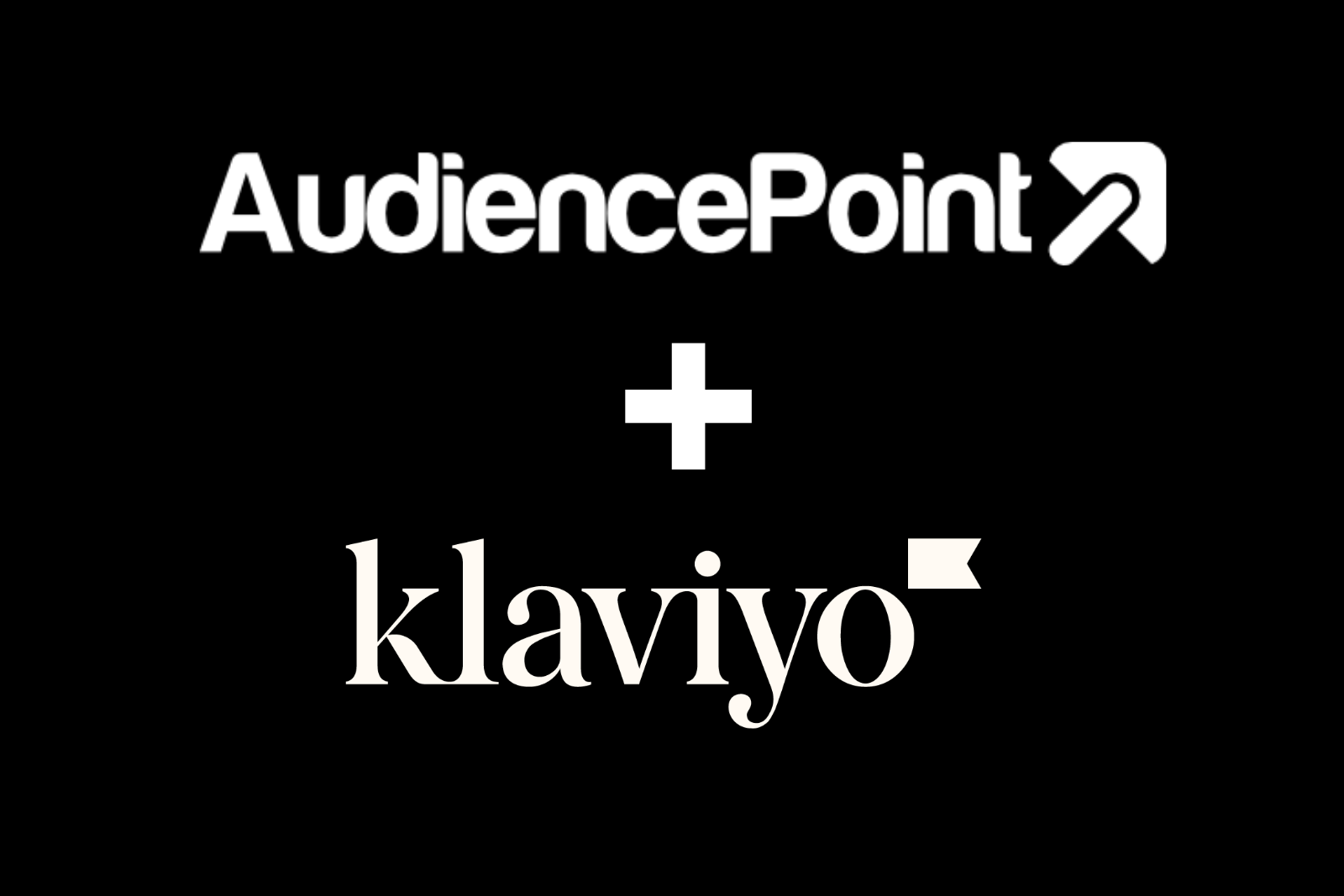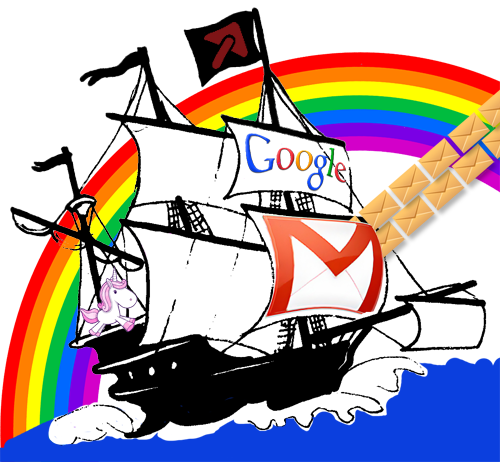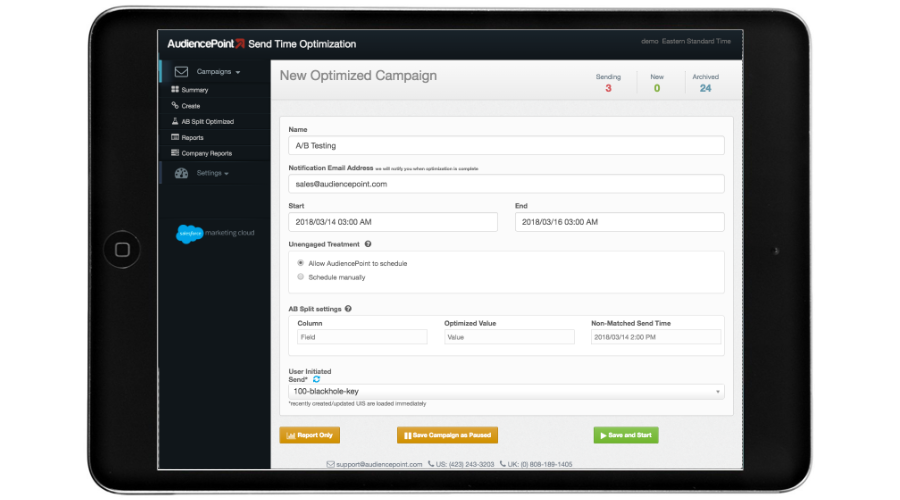AudiencePoint is thrilled to announce our new integration with Klaviyo! AudiencePoint is looking for partners to pilot our...
Email marketing has proven to be one of the most effective digital marketing channels available to businesses today. Understanding the definition of email marketing strategy is crucial for any marketer looking to leverage this tool to its fullest potential. An email marketing strategy is a comprehensive plan that guides how you intend to communicate with your audience via email to achieve your marketing goals.
Definition and Importance of Email Marketing Strategy
The term ‘email marketing strategy’ refers to a detailed plan that outlines the types of email content you will create and distribute, your target audience segments, and how you will measure success. A well-defined strategy helps ensure your email campaigns are consistent, targeted, and aligned with your business objectives.
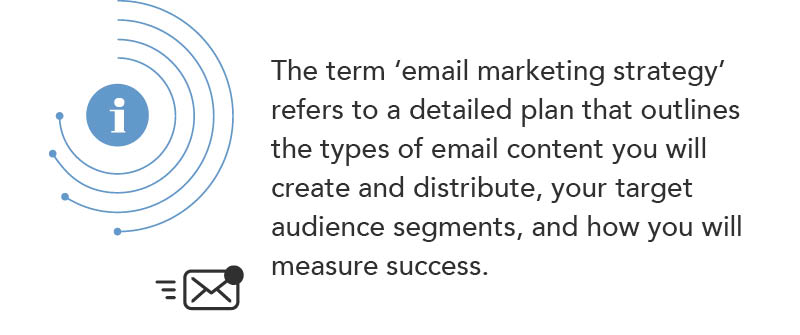
Email Marketing’s Role in Digital Marketing
As a subset of digital marketing, email marketing is pivotal in nurturing leads, engaging customers, and driving conversions. It provides direct communication to your audience, allowing for personalized content delivery, a key element in contemporary marketing. The targeted nature of email allows for higher engagement rates compared to other marketing channels, making it an indispensable part of your overall digital marketing strategy.
Benefits of a Well-Crafted Email Marketing Strategy
Creating and implementing an effective email marketing strategy offers several benefits:
- Increased ROI: Email marketing offers one of the highest returns on investment among digital marketing channels. Carefully planned and executed email campaigns can generate significant revenue.
- Improved Customer Retention: Regular, meaningful communication keeps your brand top-of-mind for existing customers, encouraging repeat business.
- Enhanced Personalization: Through segmentation and targeted messaging, you can send tailored content that resonates with different segments of your audience.
- Measurable Results: Email marketing tools provide robust analytics, enabling you to track open rates, click-through rates, and conversions, thereby continuously refining your strategy.
What Is An Effective Email Marketing Strategy?
An effective email marketing strategy is integral to any digital marketing plan. It involves using email marketing best practices to craft a detailed plan that outlines how to communicate with your audience via email to achieve specific business goals. The best email marketing strategy combines thoughtful planning, precise targeting, and ongoing optimization.
Components of an Effective Email Marketing Strategy
To create a successful strategy, start by understanding the core components:
- Email marketing strategy definition: Clearly defining your strategy helps align your email marketing efforts with your overall business goals. This includes what you aim to achieve, who your target audience is, and how email can help you achieve your business objectives.
- Setting Goals and Objectives: Establish clear, measurable goals such as increasing sales, boosting customer engagement, or generating leads. Set specific, achievable objectives that can guide your strategy toward success.
- Segmentation and Targeting: Not all recipients are the same. Segmentation involves dividing your email list into distinct groups based on criteria like demographics, purchase history, or engagement level. Targeting ensures that each group receives content that is relevant to them, improving engagement rates.
- Content Creation and Personalization: Create compelling content tailored to your audience. Personalized emails, tailored to individual recipients, can significantly increase engagement and conversion rates. Use recipient names, tailor recommendations based on past behavior, and personalize subject lines to stand out in crowded inboxes.
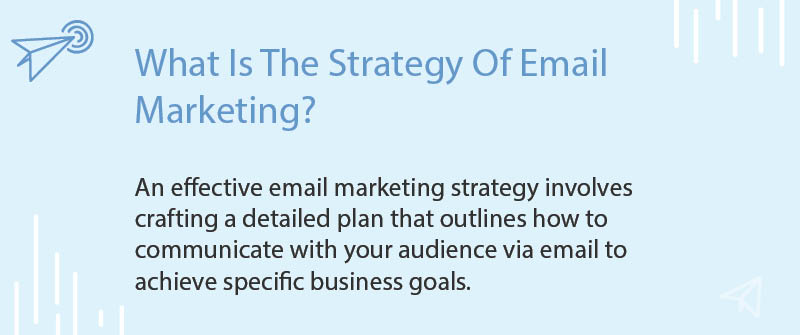
Types of Email Marketing Campaigns
Understanding the different types of email marketing is crucial for developing a comprehensive email marketing strategy. There are four primary types: transactional emails, promotional emails, lifecycle emails, and newsletter emails. Each type serves a distinct purpose and, when used effectively, can enhance your overall marketing campaign.
Transactional Emails
Specific actions taken by the recipient trigger transactional emails. These can include order confirmations, password resets, and account notifications. Their role is primarily functional, providing necessary information related to transactions or user activity. Because they are typically expected and opened promptly, they have the highest open rates among all email types. Including relevant cross-sell and upsell opportunities within these emails can also drive revenue.
Promotional Emails
Promotional emails are designed to drive sales, sign-ups, or other conversions. They might feature special offers, discounts, or invitations to exclusive events. Promotional emails are an integral part of e-commerce and retail marketing strategies. Promotional emails must have compelling subject lines, clear calls to action, and a sense of urgency to be effective. Segmentation and personalization are key, as they allow you to target offers to specific audience segments, increasing relevance and engagement.
Lifecycle Emails
Lifecycle emails are tailored to a subscriber’s stage of the customer journey. They could include welcome series for new subscribers, re-engagement campaigns for inactive users, or loyalty programs for long-term customers. The goal of lifecycle emails is to nurture relationships and guide recipients through the sales funnel, ultimately turning them into loyal customers. Monitoring user behavior and leveraging data analytics are essential for optimizing lifecycle email flows.
Newsletter Emails
Newsletter emails are often used to keep your audience informed about your brand. They can feature company news, industry updates, blog posts, and more. Newsletters help build brand trust and keep your brand top-of-mind. To be effective, newsletters should be consistently delivered, visually appealing, and packed with valuable content. Analyzing open and click rates will help you understand what content resonates most with your audience, enabling continuous improvement.
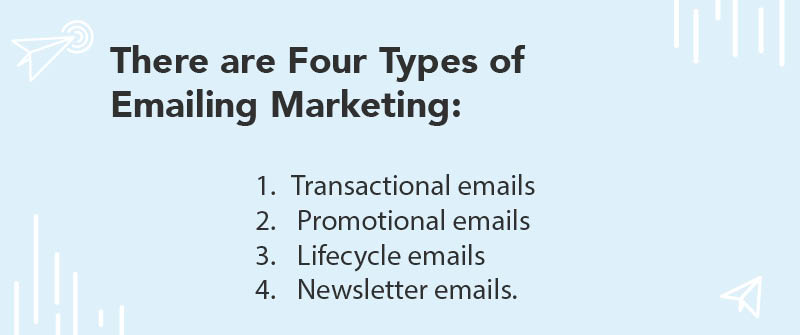
What Are The Three Components Of Email Marketing?
Step 1: Building and Managing Email Lists
Constructing a robust email list is the foundation of every successful email marketing campaign. A comprehensive email marketing strategy template helps identify the right tools and techniques for gathering and managing subscriber information. Effective list-building techniques include using sign-up forms on your website, creating lead magnets such as eBooks or whitepapers, and encouraging social media followers to join your mailing list.
Once you’ve built a list, managing it becomes crucial. This involves regularly cleaning your list to remove inactive subscribers, which ensures better engagement rates and deliverability. Employing list segmentation to organize your audience based on specific criteria such as demographics, behavior, or purchase history can also significantly improve the effectiveness of your campaigns.
Best Practices for Building and Managing Lists
- Use double opt-ins to ensure quality subscribers
- Regularly update and clean your lists
- Segment your list based on customer data for targeted campaigns
- Provide easy options for subscribers to update their preferences
Step 2: Designing and Crafting Email Content
The second step in an effective email marketing strategy involves designing and crafting compelling email content. This encompasses everything from the email template to the subject line, headlines, body text, and call-to-action (CTA). The content should be visually appealing and deliver value to the recipient.
Personalization plays a significant role here. With advanced analytics tools, you can tailor content to match subscriber interests and behaviors. Incorporate dynamic content fields to personalize greetings and recommendations. A/B testing various email elements, such as headlines and CTAs, can provide data-driven insights into what works best with your audience.
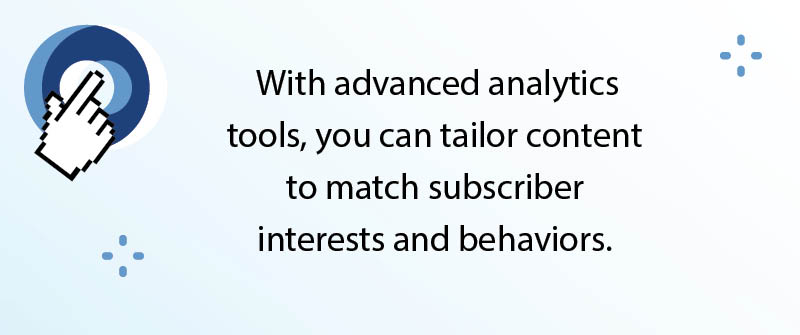
Content Creation Tips
- Keep subject lines short and engaging
- Use a balance of text and images
- Include clear and compelling calls to action
- Personalize content to increase engagement
- Test and Iterate over time
Step 3: Sending and Analyzing Campaign Performance
The final step in a successful email marketing strategy is sending the emails and subsequent analysis of the campaign’s performance. Utilizing automation tools can streamline the scheduling and sending process, ensuring your emails reach the right audiences at optimal times.
Monitoring key performance indicators (KPIs) such as open rates, click-through rates, conversion rates, and unsubscribe rates is crucial for evaluating the success of your campaigns. Use this data to identify strengths and areas for improvement. Implementing changes based on these insights is key to continually enhancing your email marketing efforts.
Analyzing Campaign Performance
- Track and analyze KPIs to measure success
- A/B test different elements to optimize performance
- Collect and act on feedback from your audience
- Continuously refine strategies based on data-driven insights
What Are The Five Steps Of Email Marketing?
A successful email marketing strategy in 2024 hinges on carefully planned and executed steps. Email marketers can deliver compelling campaigns that enhance engagement and boost conversion rates by following these five crucial steps.
Step 1: Define Objectives and KPIs
The first step in any strategic approach is to define specific objectives and Key Performance Indicators (KPIs). Objectives might include increasing website traffic, enhancing customer retention, or boosting sales. KPIs, such as open rates, click-through rates, and conversion rates, allow you to measure progress towards these goals. Establishing clear objectives and KPIs provides a roadmap for the campaign and benchmarks for success.
Step 2: Create and Segment Your Email List
Building a robust email list is fundamental. This involves capturing email addresses through subscription forms, landing pages, and other touchpoints. Segmentation of this list is equally important for targeted messaging. Segmentation criteria can be based on demographics, past purchase behavior, engagement levels, or lifecycle stages. Effective segmentation allows for personalized content that resonates with specific audience subsets, enhancing relevance and effectiveness.
Step 3: Develop Engaging and Relevant Content
Compelling content is at the heart of every successful campaign. Craft emails that are not only visually appealing but also rich in value. This includes engaging subject lines, personalized greetings, consistent branding, and clear calls-to-action (CTAs). Additionally, incorporating dynamic content and personalizing email content to address recipients’ individual preferences and behaviors can significantly boost engagement.
Step 4: Execute Your Campaign
The next critical step is deploying the campaign. This involves scheduling emails to be sent at optimal times for your audience and ensuring deliverability. To determine what works best, utilize A/B testing to experiment with different variables, such as subject lines, content formats, and send times. Automation tools can also streamline this process, providing scalability and consistency in email outreach.
Step 5: Measure Results and Optimize
Finally, analyzing the performance of your campaigns is essential for ongoing improvement. Leverage analytics to review KPIs such as open rates, click-through rates, and conversions. Identify areas of success and aspects that require tweaking. Continuous optimization based on data-driven insights can lead to better performance in future campaigns, keeping your email marketing strategy dynamic and effective.
By following these five steps—defining objectives and KPIs, creating and segmenting your email list, developing engaging content, executing your campaign, and measuring results—you can build a robust email marketing strategy for 2024 that drives results and achieves business goals.
Email Marketing Strategies for B2B
Effective email marketing strategies for B2B present unique challenges and opportunities distinct from B2C tactics. Understanding the B2B buyer cycle, personalizing content, nurturing leads, and leveraging case studies can significantly enhance the effectiveness of your campaigns.
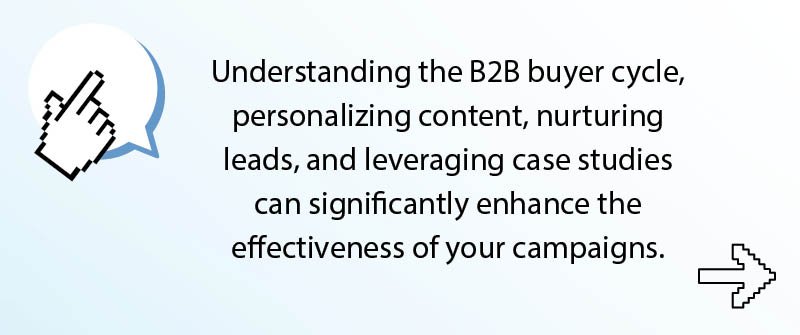
Understanding the B2B Buyer Cycle
The B2B buyer cycle is often longer and more complex than the B2C cycle. Decision-making can involve multiple stakeholders, from procurement to department heads. Therefore, the content of your emails must address these varied perspectives and stages. Ensure your emails cater to the awareness, consideration, and decision stages of the buyer’s journey.
For instance, emails at the awareness stage might focus on industry insights and educational content, while those in the consideration stage could highlight case studies and solution comparisons. Finally, emails at the decision stage should offer demos, free trials, or strong calls to action for direct engagement.
Personalization and Engagement
Personalization is not just about using the recipient’s name. B2B email marketing extends to sending content relevant to the recipient’s industry, job role, and current challenges. Use segmentation to tailor your messages, ensuring that each email provides value.
Interactive content, such as quizzes, polls, and personalized recommendations, can significantly boost engagement. Additionally, leveraging data from past interactions to inform future email content can provide your recipients with a more seamless and relevant experience.
Nurturing Leads Through Email Sequences
Lead nurturing is crucial in B2B email marketing. Effective nurturing sequences can guide potential clients through the buyer’s journey, providing pertinent information at each stage. Automated email sequences, based on triggers like user behavior or time intervals, help maintain regular contact without overwhelming your prospects.
For example, after a prospect downloads a white paper from your site, an automated sequence can follow up with related content, case studies, and, eventually, a call to action for a demo or meeting.
Case Studies and Examples of Successful B2B Email Campaigns
Learning from successful campaigns can offer invaluable insights. Case studies highlight real-world applications of B2B email strategies and their outcomes. For instance, a company that doubled its lead conversions through a well-planned email sequence offers actionable insights that can be adapted to your strategy.
Examine successful case studies to understand the mix of content, timing, and personalization that worked. By adapting these approaches, you can refine your email marketing strategy to meet your business goals better.
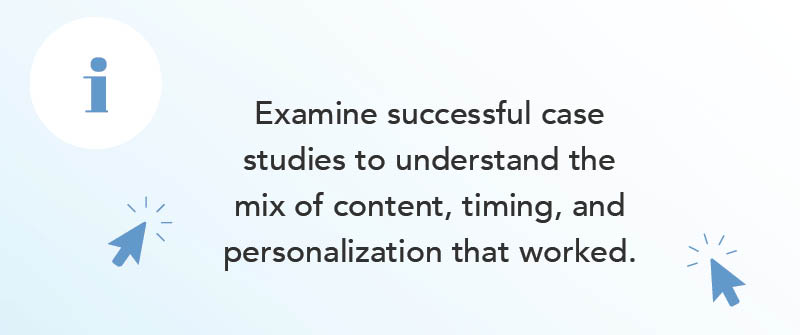
Trends and Predictions for Email Marketing in 2024
AI and Personalization in Email Marketing
As we move into 2024, the integration of AI is set to revolutionize email marketing. Marketers leverage artificial intelligence to analyze customer data and deliver highly personalized content. AI algorithms can predict user behavior, enabling the creation of hyper-targeted campaigns that resonate with individual preferences and needs. Personalization extends beyond using the recipient’s name; it includes customizing offers, newsletters, and even the send time based on user interactions and preferences.
Interactive and Dynamic Content
Another trend gaining traction in 2024 is using interactive and dynamic content within email campaigns. Interactive emails, including carousels, surveys, and images, keep recipients engaged and improve click-through rates. Dynamic content allows for real-time updates within an email, ensuring the information presented is always relevant and up-to-date. This kind of content can adapt based on user behavior or external factors, providing a more engaging and relevant experience for the recipient.
Data Privacy and Compliance
In 2024, data privacy and compliance remain critical concerns for email marketers. Maintaining compliance with regulations like GDPR, CCPA, and other emerging data privacy laws is paramount. Email marketers need to prioritize data security and implement robust data management practices. Transparent privacy policies, easy-to-understand consent forms, and mechanisms for recipients to manage their preferences are essential. Maintaining trust with your audience by demonstrating a commitment to their privacy will be crucial for the success of email marketing campaigns.
Future Innovations to Watch
Email marketing is continually evolving, and several innovations are expected to shape its future. Predictive analytics will likely expand, allowing marketers to forecast trends and personalize content like never before. Additionally, integrating email marketing with other technologies, such as virtual reality (VR) and augmented reality (AR), could open new avenues for creating immersive email experiences. Staying ahead of these innovations and adapting them to your email marketing strategy will be essential to remain competitive in 2024.
Conclusion and Best Practices
As we wrap up our exploration of effective email marketing strategies for 2024, it is essential to recap the key strategies and best practices for ongoing success in this dynamic field.
Recap of Key Strategies
We started with a comprehensive discussion about the definition of an email marketing strategy and its importance within the broader digital marketing landscape. We highlighted how a well-crafted email marketing strategy can bolster your marketing efforts by effectively engaging subscribers, driving conversions, and building lasting relationships.
We also delved into the core components of an effective strategy, including setting clear goals, segmenting your audience, and creating personalized content. Furthermore, we reviewed different types of email marketing campaigns, such as transactional, promotional, lifecycle, and newsletter emails, emphasizing the unique benefits each type offers.
Best Practices for Ongoing Success
When it comes to running successful email marketing campaigns, a few best practices stand out:
1. Always Segment Your Audience
Segmentation remains one of the most powerful strategies in email marketing. By dividing your email list into smaller, more targeted segments, you can deliver more relevant content to each group. This approach increases engagement and reduces the chances of your emails being marked as spam.
2. Focus on Quality Content
Quality content is king. Your subscribers are more likely to engage with your emails if they find the content valuable, informative, and engaging. Personalization and relevance are key factors contributing to your email content’s effectiveness.
3. Test and Optimize
Continuous testing and optimization are crucial. Track the performance of your email campaigns through metrics like open rates, click-through rates, and conversions. A/B testing elements like subject lines, email copy, and calls to action will help you understand what resonates most with your audience.
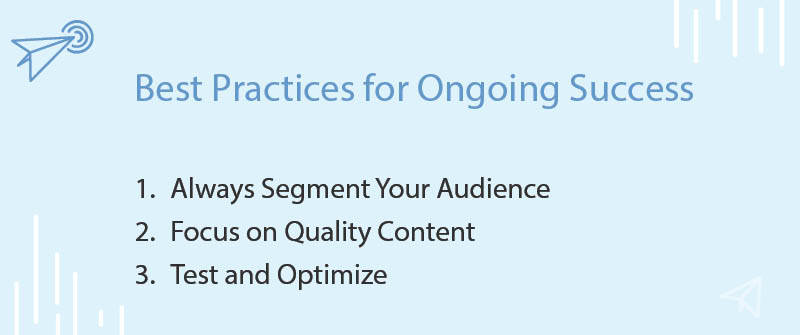
Tips for Continuous Improvement
To ensure sustained success in your email marketing efforts, consider the following tips for continuous improvement:
1. Monitor Trends and Innovations
Stay updated with the latest trends in email marketing, such as AI and interactive content, to keep your campaigns fresh and engaging.
2. Maintain Data Privacy and Compliance
Adhering to data privacy regulations like GDPR and CCPA is a legal requirement and helps build trust with your subscribers.
3. Foster Relationships
Beyond transactional interactions, aim to build relationships with your subscribers by providing consistent value through your emails. This approach will likely lead to higher loyalty and long-term engagement.
For email marketers looking to elevate their campaigns, AudiencePoint offers advanced tools that provide unparalleled insights into subscribers’ inbox habits. Our platform’s data-driven capabilities optimize email engagement, re-engagement, and deliverability, ultimately helping you maximize your campaign’s potential and revenue. Contact Audience Point today!
